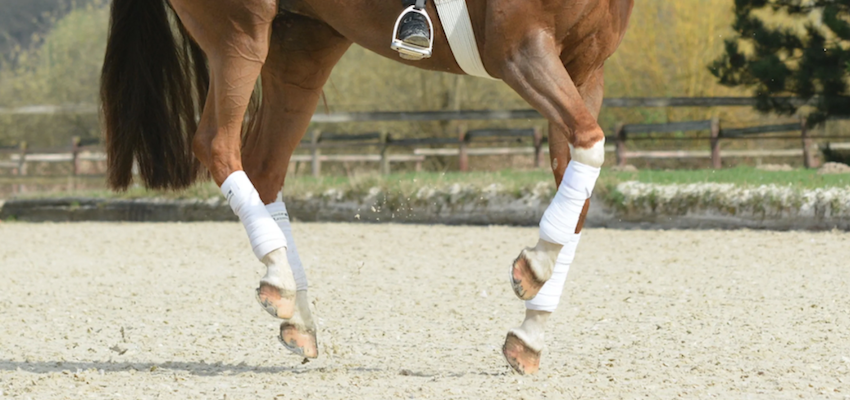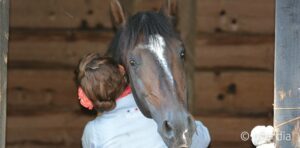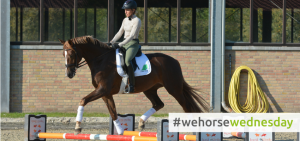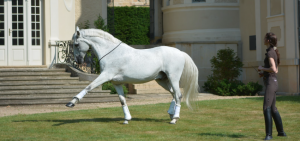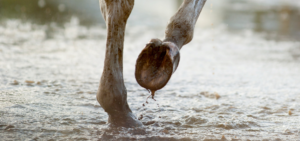Flying changes are either inevitable in the jumping course or the next step to a more advanced dressage level. Either way, it is a wonderful feeling for the rider when the horse changes leads in canter by jumping energetic and powerful into the new direction. This exercise can also be an energy booster and fun factor for the horse. Continue reading to find out how and when the flying change can be taken into your training and what to keep in mind about this exercise.
Summary
- What Are Flying Changes?
- The Biomechanics Behind It
- When to Introduce Them to Your Training?
- Dressage Changes vs Jumping Changes
- What Are Some Common Problems With Flying Changes?
- The Training of Flying Changes In Different Philosophies
What Are Flying Changes?
In a flying change, the horse changes the lead while remaining in canter: So he doesn’t have to transition into a lower gait before which would interrupt the canter flow. But the horse not only changes the direction in a flying change but also changes the dominant and forward- pushing front and hind leg. This happens in the moment of suspension, when all four feet are off the ground.
The Biomechanics Behind It
Flying changes occur in the nature of horses. If they gallop freely, it can often be seen how they automatically change the lead in canter by performing a flying change. Hence it is a movement that many horses do on their own and sometimes even offer in training without being asked to.
However, is it definitely more difficult for horses to perform the flying change with a rider on top of them. The rider’s weight has an impact on the horse’s balance and especially young horses need their time to get adjusted to the rider’s interference in order to regain their balance and strength.
Balance and strength are necessary factors for the horse to manage a flying change; Due to the switch of the dominant fore- and hindleg, the horse needs the strength and energy to arrange the leg pairs in the moment of suspension. This, of course, is not possible when the horse’s canter is not active, uphill, and steady in its rhythm yet. The horse has to move with a free shoulder and an upright head position in order to be able to do a clean flying change. To achieve this, the hindquarters have to take on most of the weight. A horse that carries most of his and the rider’s weight on the forehand, won’t manage to perform a correct flying change.
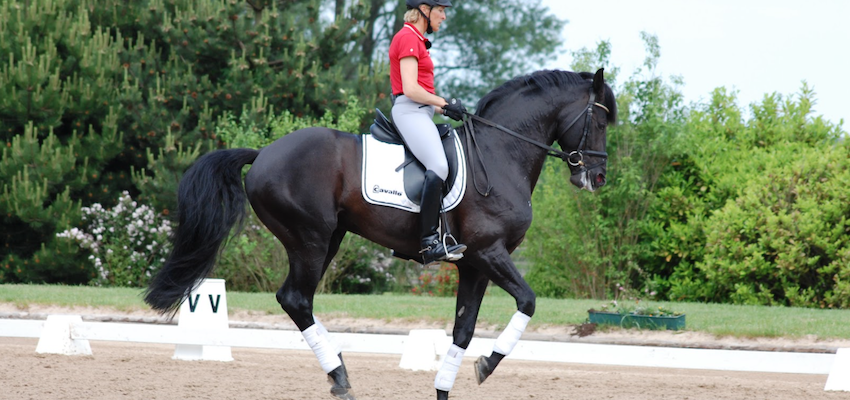
When to Introduce Them in Your Training
Before including flying changes in your training, you should be able to tick the following points off your mental list. These points apply to you as a rider, as well as to the current state of development of your horse.
First of all, you should be an experienced rider with a balanced seat and stable, calm hands that are independent of your seat. Especially, if you want to teach an inexperienced or young horse the flying changes, it is important that you can give the horse security and clear instructions by having good control over your own body and your aids.
Looking for ways to improve and refine your aids? No worries, our courses got you covered!
Your horse should have a stable and uphill canter that can already be collected to a certain degree. He should also be flexible in his body, so you can control the shoulder and hindquarters of your horse without him losing his rhythm.
There are several exercises that indicate if your horse is supple in canter and reacts well to your aids:
- Your horse should have enough strength and balance to be able to canter off from walk
- Your horse should be collected and attentive enough to be able to transition from canter into walk
- Your horse should canter balanced and uphill enough to be able to hold a steady counter canter with no change in rhythm or in quality
- Your horse should be able to move his shoulders and hindquarters when you ask him to. This can be checked with lateral movements like shoulder-in or travers
For concrete and creative exercises to start the flying changes in your training, check out our dressage online courses here.
Dressage Changes vs Jumping Changes
When riding dressage, it is important that the flying changes are performed “cleanly”- with both front and hind legs changing during the same moment of suspension. In dressage, a flying change is also ought to be expressive which is achieved by a collected canter and a prolonged moment of suspension. The hindquarters are expected to jump actively into the new direction.
Mastering the flying change in show jumping is essential in order to jump a course without any interruption that could disrupt the canter flow. So the flying change is expected to be clean but also unagitated and temperate. It is important that the horse doesn’t lose his speed and rhythm while doing the flying change because completing a course in time is an important factor in show jumping.
What Are Some Common Problems With Flying Changes
A commonly seen mistake is when the horse changes the front leg first in one stride. Afterwards the hind leg follows behind in the next stride. But the goal is that the front- and hindlegs change together within one canter stride!
Sometimes the horse only changes with the front legs but not with the hind legs which leads to the incorrect and rather unpleasant cross canter.
Another mistake is if the horse overturns while doing the flying change and falls extremely onto the side of the new direction.
Or the horse starts to take off after the change and canters far too flat and too fast.
All of these mistakes have to do with a lack of balance and security. The horse and also the rider needs time to internalize this new movement and to adjust the body to it. It is helpful to ask yourself which part of your horse’s body wasn’t flexible enough? Did it fall apart in the canter? Was the canter too slow or too fast? Did you exaggerate the aids and caused your horse to lose his balance? Was the horse crooked before the change?
But most importantly: give your horse and yourself a break: Don’t practice the flying changes nonstop. It makes more sense to dissolve potential blockades and become conscious of your aids and seat. Calming the horse down before trying to do another flying change, makes more sense than continuing the training with a hot and unattentive horse.
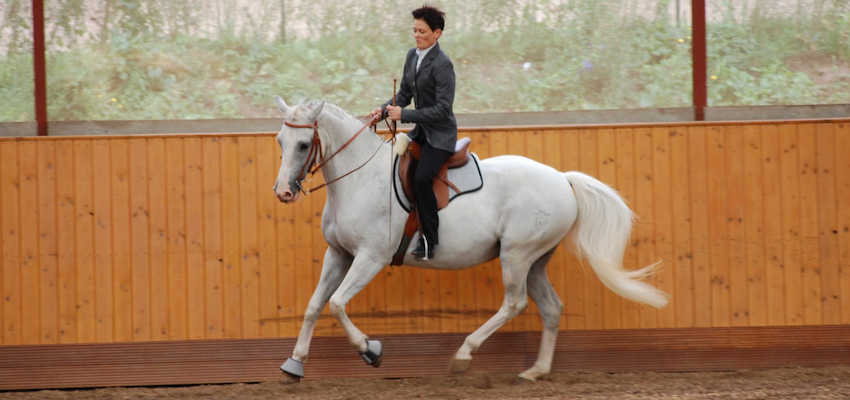
The Training of Flying Changes In Different Philosophies
The approach to introduce flying changes to horses can look very different. There are several exercises with a different main emphasis that are going to be introduced. It makes sense to pick out the training methods that fit best to your horse and to have a look at what different trainers have to say about flying changes.
School of Légèreté
The school of légèreté focuses on lateral movements as preparation for the flying changes. Philippe Karl states that one side has to be made lighter than the other in order to promote the forward movement, so the weight shift of the rider is the key element. The horse on the other hand is ought to have a very high head position with an open angle and an extended neck.
Exercises that help to prepare the flying change, are sequences of counter canter, travers in a volt that evolves into half-pass in a high frequency. Other exercises are; collected canter and shoulder-in on a circle or counter-canter on a circle that pushes the horse to do the flying change more willingly into the more “comfortable” direction.
Working Equitation
When the flying change is practiced in Working Equitation, ground poles and pylons are put to use. The exercises include tight turns around the pylons and many “canter-walk” and “walk-canter”- transitions in the ground pole- corridor. So the working equitation course plays a big role when it comes to training the flying changes. The goal is to get the horse supple and very attentive. The rider should use his aids very precisely which is encouraged by the course.
Other exercises are cantering off directly after letting the horse step backwards and doing a transition or even the flying change in the corridor, so the horse starts to learn that something is asked from him in the corridor and he learns to wait for the rider’s aids.
In general, the horse’s movements are slower than in English dressage and the neck of the horse is very round and not too upright.
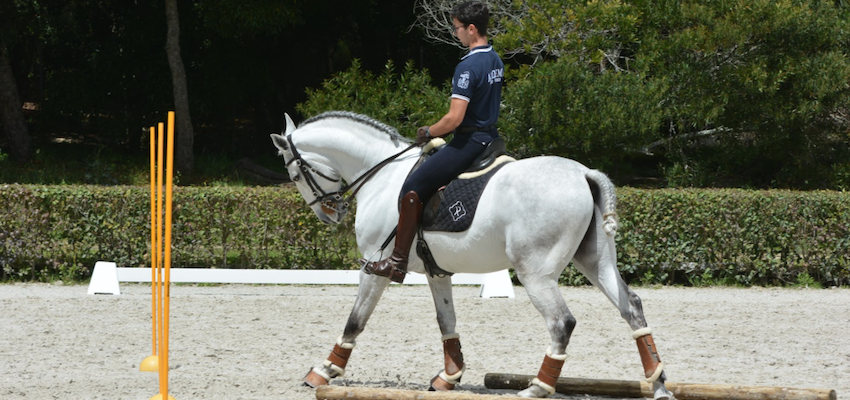
English Dressage
The approach in English dressage for introducing and practicing a flying change is a bit different than in the philosophies above. The basis is a supple and straight horse that has contact on both reins while cantering. A crooked horse can’t do a flying change due to the lack of balance and flexibility in its body.
Common exercises for the preparation are shoulder-fore or shoulder-in on a circle, in order to control the shoulders of the horse and to get the hindquarters below the center of gravity. If the horse carries most of the weight on his hindquarters, then the shoulder can move freely and the topline comes up which is necessary for a flying change; So the nose should be in a forward position and the hindquarters active.
Decreasing the circle in the canter, travers on the circle, and tempi- transitions within canter, are also very good exercises for collecting the horse. Keep in mind that half- halts are very important aids that collect the horse and make it attentive.
A common exercise that introduces the horse to the flying change is cantering over, either a cavaletti, or ground pole that is located on the diagonal or in the middle of two circles. When jumping over a cavaletti or ground pole, the horse is longer in the air and has more time to rearrange its legs to the new lead. So the option is, either, to change across the diagonal or to change direction through a circle. When warming up the flying changes can also be ridden with a bit more speed. Some horses also learn the flying changes through half pass.

